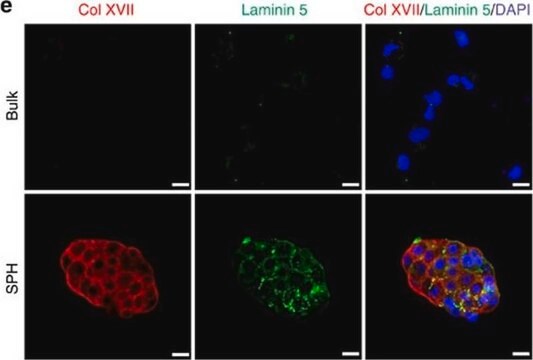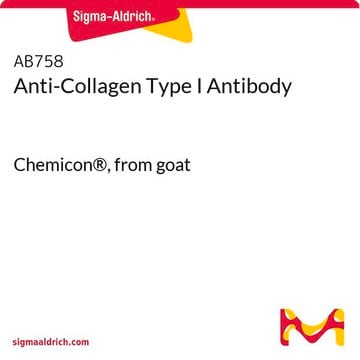AB755P
Anti-Rat Collagen Type I Antibody
Chemicon®, from rabbit
Synonym(s):
Anti-CAFYD, Anti-EDSC, Anti-OI1, Anti-OI2, Anti-OI3, Anti-OI4
About This Item
Recommended Products
biological source
rabbit
Quality Level
antibody form
affinity isolated antibody
antibody product type
primary antibodies
clone
polyclonal
purified by
affinity chromatography
species reactivity
rat
manufacturer/tradename
Chemicon®
technique(s)
ELISA: suitable
immunocytochemistry: suitable
immunohistochemistry: suitable (paraffin)
radioimmunoassay: suitable
isotype
IgG
suitability
not suitable for Western blot
NCBI accession no.
UniProt accession no.
shipped in
wet ice
target post-translational modification
unmodified
Gene Information
human ... COL1A1(1277)
General description
Specificity
Immunogen
Application
A 1:200 dilution of a previous lot was used in ELISA.
RIA:
A previous lot of this antibody was used in RIA.
Immunocytochemistry:
A 1:40-1:80 dilution of a previous lot was used for immunofluorescent staining of frozen rat skin and liver tissues.
Can also be used for acetone-fixed cells.
Immunohistochemistry:
1:40-1:80 dilution for immunofluorescent staining of frozen rat skin and liver tissues. The antibody is also reactive on paraffin embedded rat tissues (skin, liver) at a tdilution of 1:500 using an ABC detection system.
Not recommended for Western blots.
Optimal working dilutions must be determined by the end user.
Quality
Collagen Type I (cat. # AB755P) staining pattern/morphology in rat skin. Tissue is pre-treated with Citrate pH 6.0, antigen retrieval. This lot of antibody is diluted to 1:1000, using IHC-Select reagents used with HRP-DAB. Immunoreactivity is seen fiber-staining on paraffin section. Note that the staining pattern is as expected.
IHC-Paraffin Staining With Epitope Retrieval: Rat Skin
Physical form
Analysis Note
Rat hepatic stellate cell lysate
Other Notes
Legal Information
Not finding the right product?
Try our Product Selector Tool.
Storage Class
13 - Non Combustible Solids
wgk_germany
WGK 1
flash_point_f
Not applicable
flash_point_c
Not applicable
Certificates of Analysis (COA)
Search for Certificates of Analysis (COA) by entering the products Lot/Batch Number. Lot and Batch Numbers can be found on a product’s label following the words ‘Lot’ or ‘Batch’.
Already Own This Product?
Find documentation for the products that you have recently purchased in the Document Library.
Our team of scientists has experience in all areas of research including Life Science, Material Science, Chemical Synthesis, Chromatography, Analytical and many others.
Contact Technical Service








